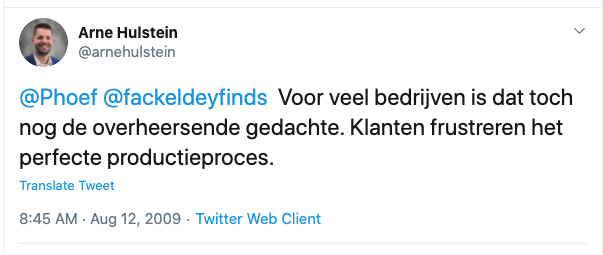De heffing is geweldig. “Overheid, help!”
Vandaag stond in Trouw te lezen dat de commissie Brinkman vandaag adviseert om een heffing op internetaansluitingen in te stellen vanuit de overheid. De heffing moet gebruikt gaan worden om innovatieve initiatieven in de krantenwereld te financieren. In april besloot de Stichting Onderhandelingen Thuiskopievergoeding (SONT) al om een heffing in te voeren op digitale opname en afspeel appraratuur met een opslagmogelijkheid. De heffing is geweldig.
Het klinkt misschien wat overdreven, maar ehct, de heffing is geweldig. De heffing is het enige middel dat er voor zorgt dat een verouderd businessmodel toch kan blijven renderen. Want uiteindelijk komt het daar op neer. Het internet is immers niet nieuw. De kranten hebben al heel lang aan zien komen dat er andere maniere van nieuwsgaring gaan ontstaan. Ze konden op hun klompen aanvoelen dat het businessmodel dat is ontstaan rond 1605 met Relation, wellicht de 21e eeuw niet zou gaan overleven. Ook omdat het delen van nieuws via het internet al een van de meest populaire activiteiten was.
Op een andere manier geldt hetzelfde voor artiesten. De structuren die de afgelopen eeuw zo succesvol zijn geweest, worden langzaam onderuit gehaald door het gemak van downloaden en bestandsdeling. Ook hier konden de platenmaatschappijen al jaren geleden aan zien komen dat de huidige manier van verkopen langzaam zijn einde zou gaan vinden. Half jaren negentig waren muziek en films al te vinden via de ftp sites van diverse universiteiten. En hoewel de kwaliteit toen nog te wensen overliet, was te voorzien dat dat binnen afzienbare tijd zou gaan veranderen.
Op het moment dat je geconfronteerd wordt met een verouderd businessmodel en teruglopende inkomsten, kon je maar twee dingen doen. Je kon erin berusten en langzaam ten onder gaan, of je kon je schouders er onder zetten en een nieuw model maken om weer geld te verdienen. Nu is er de derde optie. Je gaat naar de overheid, je klaagt en je stelt een commissie in. De commissie brengt dan een advies uit voor een heffing, zodat je niet zelf hoeft te investeren in een nieuw businessmodel voor je product. Ideaal. Maar als ik heel eerlijk ben, dan zie ik dat niet als meer dan een doekje voor het bloeden. Want succesvolle ondernemingen en succesvolle producten komen voor uit visie. Vanuit die visie komen ook de mogelijkheden om geld te verdienen met je product. En mocht dat niet meteen lukken, dan pas je je businessmodel wat aan, net zo lang tot je verdient. Want consumenten zijn best bereid om te betalen, als het maar is voor iets waarin ze waarde zien.
Vandaag stond in Trouw te lezen dat de commissie Brinkman vandaag adviseert om een heffing op internetaansluitingen in te stellen vanuit de overheid. De heffing moet gebruikt gaan worden om innovatieve initiatieven in de krantenwereld te financieren. In april besloot de Stichting Onderhandelingen Thuiskopievergoeding (SONT) al om een heffing in te voeren op digitale opname en afspeel appraratuur met een opslagmogelijkheid. De heffing is geweldig.
Het klinkt misschien wat overdreven, maar ehct, de heffing is geweldig. De heffing is het enige middel dat er voor zorgt dat een verouderd businessmodel toch kan blijven renderen. Want uiteindelijk komt het daar op neer. Het internet is immers niet nieuw. De kranten hebben al heel lang aan zien komen dat er andere maniere van nieuwsgaring gaan ontstaan. Ze konden op hun klompen aanvoelen dat het businessmodel dat is ontstaan rond 1605 met Relation, wellicht de 21e eeuw niet zou gaan overleven. Ook omdat het delen van nieuws via het internet al een van de meest populaire activiteiten was.
Op een andere manier geldt hetzelfde voor artiesten. De structuren die de afgelopen eeuw zo succesvol zijn geweest, worden langzaam onderuit gehaald door het gemak van downloaden en bestandsdeling. Ook hier konden de platenmaatschappijen al jaren geleden aan zien komen dat de huidige manier van verkopen langzaam zijn einde zou gaan vinden. Half jaren negentig waren muziek en films al te vinden via de ftp sites van diverse universiteiten. En hoewel de kwaliteit toen nog te wensen overliet, was te voorzien dat dat binnen afzienbare tijd zou gaan veranderen.
Op het moment dat je geconfronteerd wordt met een verouderd businessmodel en teruglopende inkomsten, kon je maar twee dingen doen. Je kon erin berusten en langzaam ten onder gaan, of je kon je schouders er onder zetten en een nieuw model maken om weer geld te verdienen. Nu is er de derde optie. Je gaat naar de overheid, je klaagt en je stelt een commissie in. De commissie brengt dan een advies uit voor een heffing, zodat je niet zelf hoeft te investeren in een nieuw businessmodel voor je product. Ideaal. Maar als ik heel eerlijk ben, dan zie ik dat niet als meer dan een doekje voor het bloeden. Want succesvolle ondernemingen en succesvolle producten komen voor uit visie. Vanuit die visie komen ook de mogelijkheden om geld te verdienen met je product. En mocht dat niet meteen lukken, dan pas je je businessmodel wat aan, net zo lang tot je verdient. Want consumenten zijn best bereid om te betalen, als het maar is voor iets waarin ze waarde zien.

 I love the future. I have loved it ever since I started reading. Technology is shaping our future fast. Back in 1985 I wrote my first computer program. Back in 1994 I launched my first website and I have been working with organizations on integrating new technology ever since.
I love the future. I have loved it ever since I started reading. Technology is shaping our future fast. Back in 1985 I wrote my first computer program. Back in 1994 I launched my first website and I have been working with organizations on integrating new technology ever since.